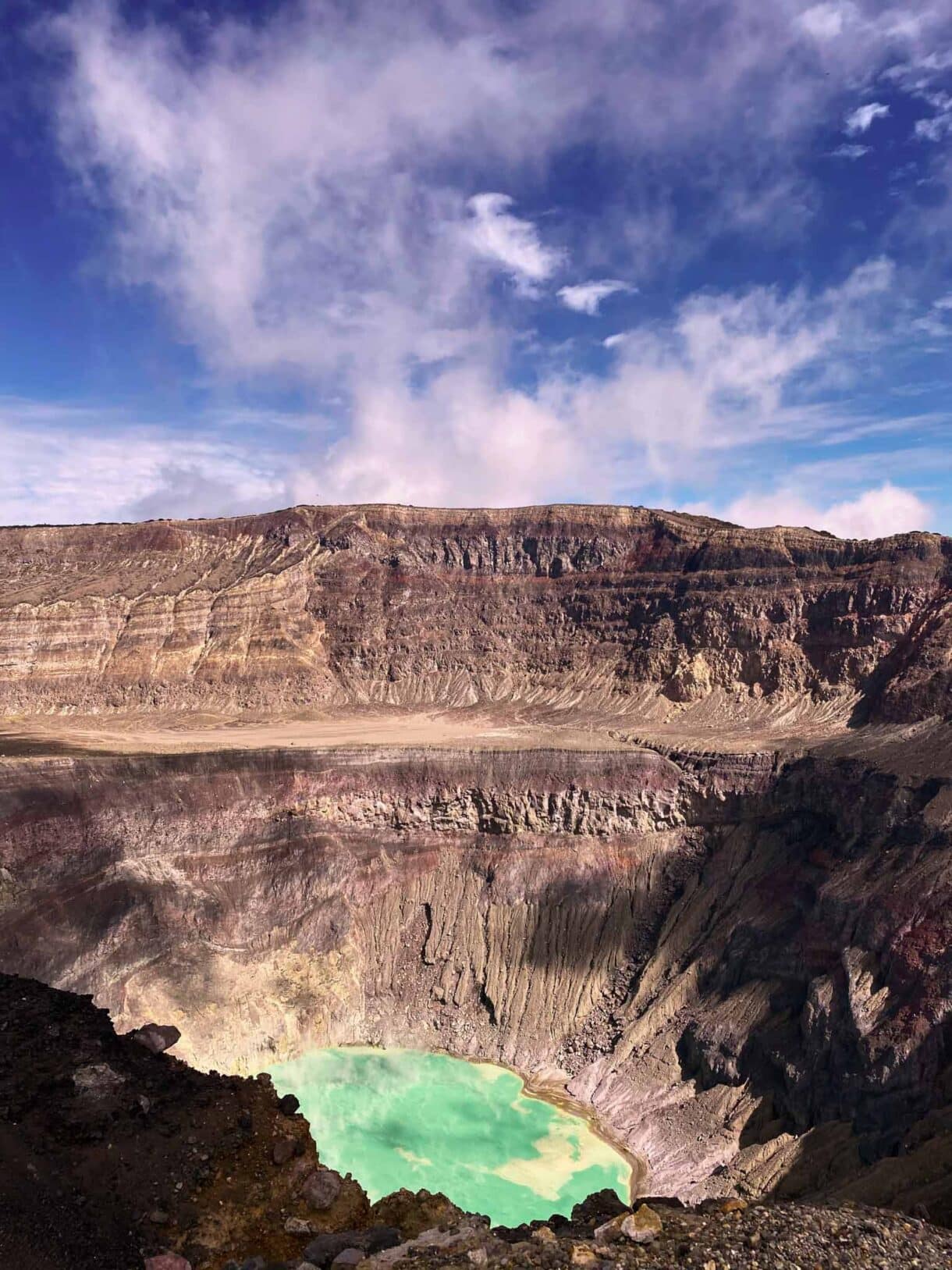
The ULTIMATE guide to the Santa Ana Volcano Hike, El Salvador [2024]
When you’re travelling in Central America, a lot of people will tell you to skip El Salvador (along with neighbouring Honduras!). They’ll tell you that it’s dangerous and that there there’s not much going on there anyway. You can choose to believe them and skip this soulful country. But then you’ll be missing out on the amazing Santa Ana Volcano Hike.
Keep reading for the ULTIMATE guide to the Santa Ana Volcano hike (it’s more in-depth than anywhere else, we’ve checked!)
Hiking up the Santa Ana Volcano is one of the most amazing things to do in El Salvador. It’s beautiful, budget-friendly, fairly easy to reach by public transport, and you don’t need to be super fit. This makes it a great volcano hike for beginners (or a great warm up hike if you’re heading to hike Guatemala’s Acatenango!).
We want you to get the best out of your experience in El Salvador! In this article, we’ll share everything we wish we knew about the Santa Ana Volcano hike, and how to do it without shelling out a load of cash.
So, here’s everything you need to know before you tackle the Santa Ana Volcano hike!
Jump to:
- Where is the Santa Ana Volcano?
- Why do the Santa Ana Volcano hike?
- How to get to the Santa Ana Volcano?
- How to find the trailhead?
- How to find the guide for the Santa Ana Volcano hike?
- Do I need a guide?
- What to expect before the hike
- What to expect on the Santa Ana Volcano hike
- How to get back to Santa Ana afterwards
- Total cost of the Santa Ana Volcano hike
- Is the Santa Ana Volcano hike safe?
- Is the Santa Ana Volcano hike difficult?
- What to pack & what to wear for the Santa Ana Volcano hike?
- When is the best time to do the Santa Ana Volcano hike?
- How to get to Santa Ana?
- Other amazing things to do near the Santa Ana Volcano
- Is the Santa Ana Volcano hike worth it?
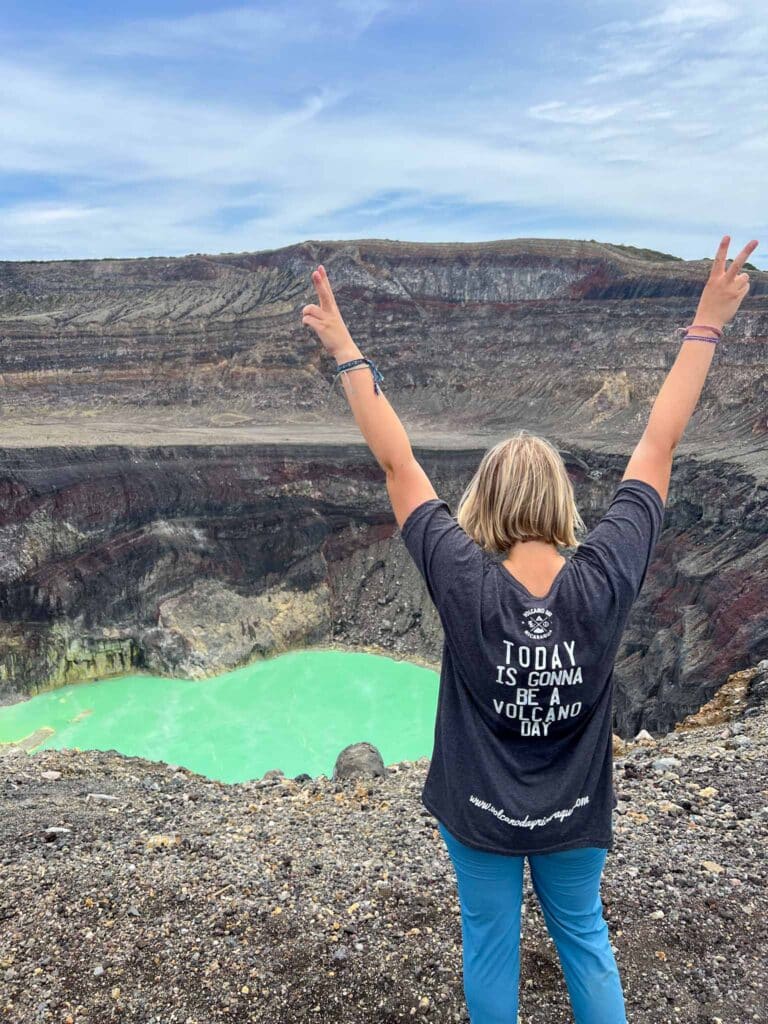
Santa Ana Volcano’s Crater Lake
WHERE IS THE SANTA ANA VOLCANO?
El Salvador is a land of volcanoes. This tiny country has 23 in total, and the beautiful diverse landscapes to go with them! With rolling green hills that climb from the seemingly endless coast, ending in iconic peaks, El Salvador is a volcano-lover’s paradise. Even the two largest lakes in the country — Coatepeque and Ilopango — were formed by massive volcanic eruptions thousands of years ago.
The Santa Ana Volcano (also known by the name Ilamatapec) is the highest volcano, and highest point, in El Salvador at 2,381 meters (7,812 feet). It’s located in the beautiful National Park Cerro Verde, in western El Salvador. This is south of the city of Santa Ana and to the west of Lake Coatepeque.
This active volcano last erupted in 2005, further revealing a gorgeous crater lake that looks either blue or green depending on the weather. It’s unusual, unique, and easy to get to.
WHY DO THE SANTA ANA VOLCANO HIKE?
If you’ve just arrived from Nicaragua or Guatemala you might be sick of volcanoes. But trust me, the Santa Ana Volcano hike is different.
Santa Ana Volcano is El Salvador’s most active volcano, and has a stunning emerald crater lake at the top. It can also sometimes appear blue or turquoise depending on the weather! You definitely can’t swim in there, but it’s beautiful to look at nonetheless.
It’s not just the stunning crater lake that is amazing, but the panoramic views. Santa Ana volcano is the highest point in the whole of El Salvador. If the weather is clear, you can see all the way across El Salvador to the Pacific Ocean. There are also breathtaking views of other volcanoes, lakes and valleys from the trail.

Santa Ana Volcano Panoramic Views
HOW TO GET TO THE SANTA ANA VOLCANO?
Santa Ana isn’t a bustling backpacker hub just yet, but it’s getting there! This does mean that (at the moment at least!) it can be hard to find a tour company. When you do find one, they’re usually overpriced and not worth the money.
But not to worry, getting to the Santa Ana Volcano hike is really easy with public transport.
To get to the Santa Ana Volcano hike, you’ll need to catch a chicken bus. These tend to have a bad reputation, but we used them across the whole of Central America, and they’re comfortable, safe and cheap.
Catch the bus 248 from La Vencedora Bus Station in Santa Ana. This isn’t the main bus station! It’s a smaller one, on the corner of 11a Calle Poniente and Avendida Fray Felipe Jesus in Santa Ana. It’s an actual building with a ticket booth and waiting area and it’s pretty easy to miss if you’re expecting the usual craziness of a Latin American Terminal de Autobuses.
If you want to make the hike, you MUST catch the first bus of the day, which leaves at 7:30am. If you miss this bus, you will get there too late and you will not be allowed to hike. We recommend arriving at least ten minutes early so that you have time to buy your ticket.
Top tip: There is a grocery store opposite the bus station. We strongly recommend picking up some snacks. Doing this hike on an empty stomach is no fun (yep, we’re talking from experience!)
When you get on, tell the bus driver that you want to go to Volcán de Santa Ana.
The bus ride costs $0.90 USD. The price could change, but it will always be on display at the front of the bus. The drive takes around two hours, and offers some stunning views over the valleys and Lake Coatepeque.
You’ll need to get off in a town called El Tibet. Don’t worry about missing your stop! The driver will let you know when to get off by shouting ‘volcano’ down the bus. Plus, the Santa Ana Volcano hike is very popular, and there will probably be lots of other tourists on your bus getting off with you.
HOW TO GET TO THE TRAILHEAD OF THE SANTA ANA VOLCANO HIKE?
The Santa Ana volcano hike begins at Cerro Verde National Park. Lots of blog posts will tell you that groups leave with a local guide at 11 am.
This is outdated advice, and it is wrong.
As El Salvador has become a safer place to travel, the Santa Ana Volcano hike has skyrocketed in popularity. The guides know that the bus from Santa Ana usually arrives between 9 and 9:30 am, so they’ll be waiting at the bus stop, ready to guide you to the hike start when you arrive.
This is great because it means that you don’t have to wait around! But it also means that you will not have time to grab a snack before the hike starts.
We’d read somewhere that most people have breakfast at one of the roadside cafés before the hike and were relying on grabbing a few pupusas. But we ended up with a snickers bar for breakfast and rumbling tummies all the way up the volcano – not the best start to the day!
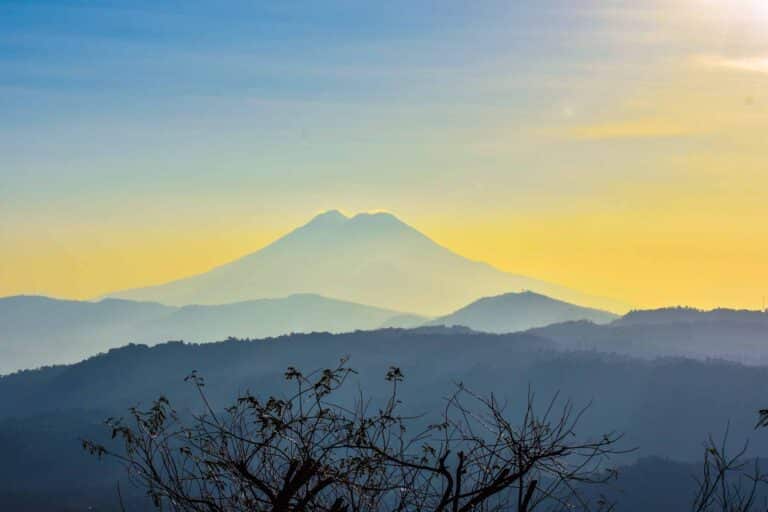
Santa Ana Volcano at sunrise from Juayua
HOW TO FIND THE GUIDE FOR THE SANTA ANA VOLCANO HIKE?
Once off the bus, you’ll be herded into a group and assigned a local guide. The guides are easy to spot, as they’re in uniform. Together you’ll walk up the paved road a couple of hundred meters.
Your guide will then give you a brief overview of the hike, and explain some rules of the National Park. It’s all in Spanish, but the key messages are to take it easy, not rush and never to leave the group (this last one is a bit more of a guideline than a hard and fast rule). They’ll also remind everyone not to litter, bring noisy speakers, or carry weapons. Don’t hesitate to ask a Spanish-speaker in your group to translate for you if you want the full information.
After you’ve agreed to the rules, you’ll need to pay the guides. Although the guides are volunteers and the fee is meant to be a tip, our experience was that this was a mandatory tip.
This non-negotiable ‘tip’ costs $3.00 USD and it all goes straight to the local guides standing in front of you. In exchange, you’ll get a little ribbon to tie onto your wrist or backpack. Keep hold of this – it’s proof that you’ve paid!
WAIT, DO I NEED A GUIDE?
Yes, according to the national park guidelines, it is an official requirement to have a guide for the Santa Ana Volcano hike (even though it’s arguably not needed).
We honestly didn’t see why you’d need a guide for the Santa Ana volcano hike. The trail isn’t signposted, but it’s fairly obvious and easy to follow. You’ll be part of a steady stream of hikers up and down anyway, so it’s difficult to get lost. Indeed, lots of Salvadorans do this by themselves, or with their families.
Although the guides do give interesting facts about the local nature and landscapes, most of them don’t speak English (which is fine, we never expect this!). But this means that, if your Spanish is rusty, you’ll also struggle to make the most of their amazing local knowledge.
We’ve heard from a handful of other travellers that it’s possible to do the hike without using a guide if you show up early enough at the trailhead. But we don’t see how this would be possible, as the first bus out of Santa Ana is the 7:30 am bus, which will arrive in time to meet the guides.
I don’t always love guided tours either, we’d much rather do it ourselves at our own pace. But in Central America, we had to learn to embrace guided tours a bit more often than we usually would.
The group will spread out once you’re through the national park office, and the guides don’t really care. Our group was so big that there was no way one or two guides could keep control of everyone. Everyone walked at different paces. At one point, we had to head back down to catch the 1 pm bus and there was no sign of our guides anywhere!
Even if going without the guides is possible, we’d recommend that you use them anyway. It only costs a few dollars and you’ll be supporting local jobs and the community. Plus, hiking as part of the group is a great way to meet other travellers and make new friends.
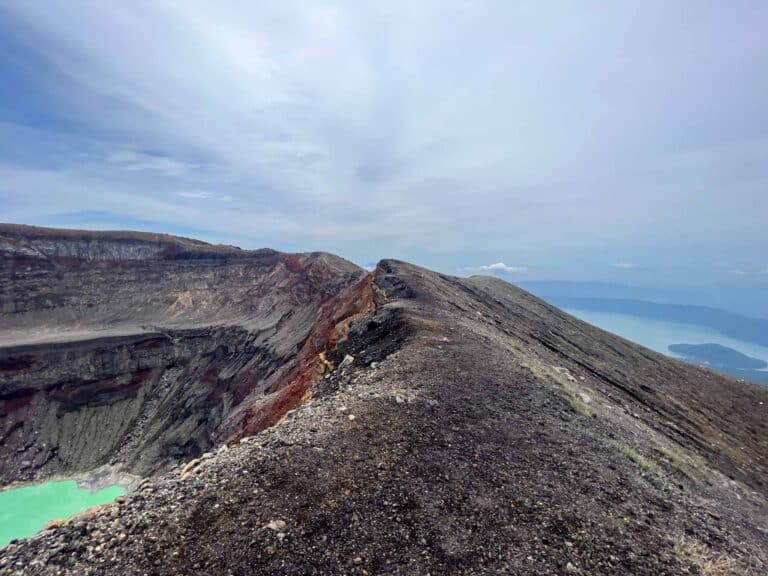
Santa Ana Volcano’s Crater Lake with Lake Coatapeque in the background
WHAT TO EXPECT BEFORE THE SANTA ANA VOLCANO HIKE STARTS?
Walk to the National Park ticket office and pay $6 USD for your park entrance. This helps to pay for the upkeep of the trail, and for the armed guards along the trail, which keeps you safe (more on that later!).
You have to wait for 10 to 15 minutes here, so you’ll have time to grab a snack and use the bathrooms. There are a few stores but they only sell snacks, such as chocolate bars and chopped fruits. It’s better than nothing if you haven’t had breakfast at least.
The bathrooms are free and actually pretty nice. Again, lots of the information online from other travel bloggers is out of date. The toilets have since been upgraded, they’re clean with flushing toilets, sinks, and plenty of soap. We recommend you use them, as there’s not really anywhere to go once you’re on the trail.
Top tip: If you’re new to Central America, make sure to grab some toilet paper before you go into the cubicle, otherwise you risk being caught short!
The guide will gather the group, check that everyone’s paid (this is why you hold onto your ribbon!) and you’ll start the hike. You’ll have to show your National Park ticket, so keep hold of this too!
WHAT TO EXPECT ON THE SANTA ANA VOLCANO HIKE?
The hike starts off fairly easy with only slight inclines and declines through a lush, green forest. There isn’t much elevation gain at this point, and the shade of the trees provides a cooling comfort from the Salvadoran sun.
Shortly after you start the hike, there’s a lookout tower that you can climb (if you want!). You’ll get great views on a clear day. But it wobbles a bit, so it’s not for those with a fear of heights. You’ll come down the same route, so you can save it for later if you like.
After the tower, the hike gets more difficult. The forest vegetation thins, eventually giving way to a rocky route. In some places, you’ll need to climb over rocks. But it’s nothing you can’t do with an average level of fitness. As you continue on the Santa Ana Volcano hike, you’ll see another volcano, Izalco, beginning to emerge in the distance.
Along the way, there are several nice viewpoints to enjoy. Take your time, enjoy the views, and take lots of photographs!
After about 1.5 to 2 hours you’ll reach the top of Santa Ana Volcano. You can look down into the turquoise-blue crater lake and take a few photos. The weather can really affect the views on this hike, but on a good day, you can see all the way to the Pacific!
Top tip: The top can be crowded, especially on a weekend. If you keep walking along the crater rim then you can still find a good spot to take pictures without people blocking the view.
There was a guy selling ice creams and popsicles at the top when we were there too. This can be a really nice reward after the steep incline, so don’t forget to bring some small bills if you’d like one.
When you’ve enjoyed the views and taken enough photos you can head back down the same way you came. From the ticket office, you can head right instead of straight on for a shortcut along paved roads instead of through the forest paths.
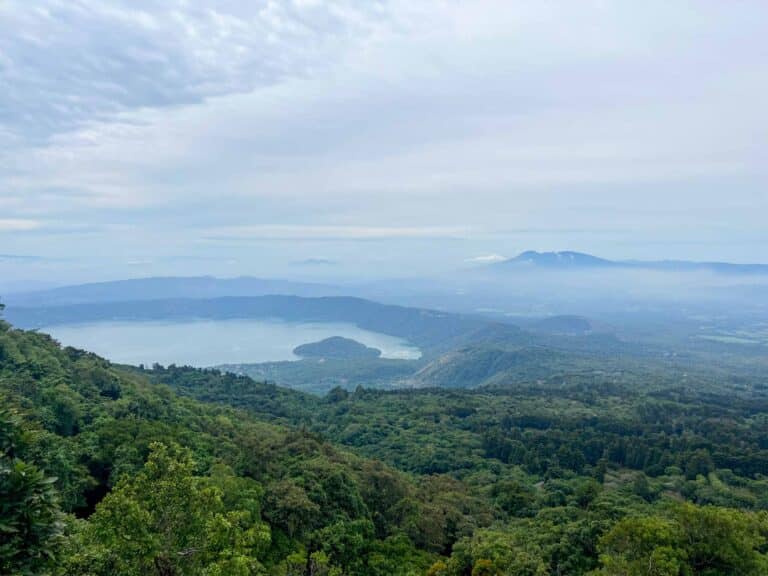
Jungle views on the hike
HOW TO GET BACK TO TO SANTA ANA AFTER THE VOLCANO HIKE?
Once you get back down, you can wait for the bus. Buses are scheduled for 1 pm and 4 pm. They will stop opposite the handful of shops and restaurants where it dropped you off.
Unless you’re a very slow walker, or you spend ages at the top taking photos, it’s perfectly feasible to make it back for the 1 pm bus. I’m not the fastest hiker, but we made it back down with time to spare.
The buses aren’t the most reliable and can easily be 30 minutes late. But there’s no way of knowing, so you need to be waiting at the bus stop in time. While waiting, there is a small local restaurant serving Pupusas for $0.50 USD and coffee for $0.35 USD. Bring some cash as the food was really good and nothing is better than eating while waiting.
Don’t worry about missing the bus! You’ll see it and hear it groaning and spluttering black smoke as it heads up the hill. The driver has a short break at the top of the hill, then comes back down to pick everyone back up.
Top tip: If you want to make it down for the 1 pm bus, we recommend that you leave the peak of the volcano no later than midday.
If you miss the 1 pm bus, you’ll have to wait until 4pm. The 4pm #248 bus sometimes finishes its route early, in a town called Puente El Congo. From Puente El Congo, you will need to board bus #59 to reach Santa Ana town.
TOTAL COST OF THE SANTA ANA VOLCANO HIKE
All of the fees at Santa Ana Volcano are cash only (US Dollars). They don’t have any way to accept credit cards or online payment, so bring at least $15 USD. Bring more if you want to buy snacks!
Bus from Santa Ana to Cerro Verde – $0.90 USD
Cost of Guide – $3.00 USD
Entrance to Cerro Verde National Park – $6.00 USD
Bus from Cerro Verde back to Santa Ana – $0.90 USD
Total Cost: $10.80 USD
I’ve seen other guides online mention an additional national park entry fee of $3 USD on top of the park entrance fee ($6 USD) and guide tip ($3 USD). Some hikers also mentioned being charged a $1 USD ‘access fee’ over private land.
We didn’t experience either of these, and recent reports from late 2022 and early 2023 also confirm that these fees are no longer in place (yay!).
If you visit and the costs have changed, please let us know! We try to keep this blog up to date so that we can provide the best advice, for free, to travellers.
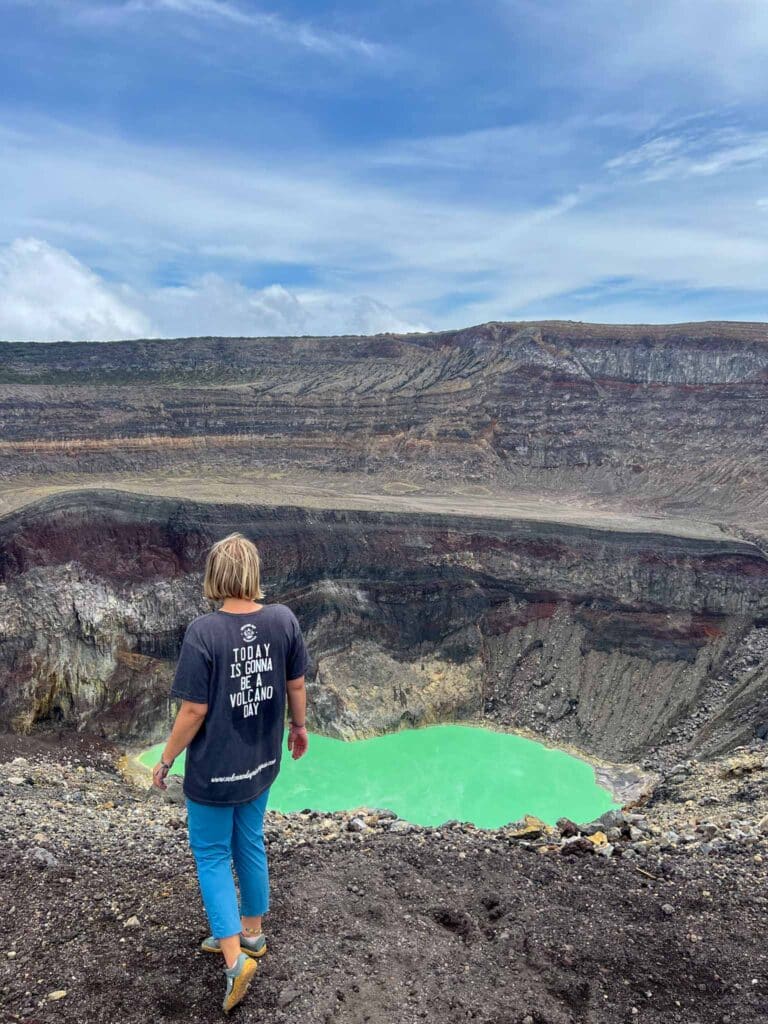
Today is gonna’ be a volcano day!
IS THE SANTA ANA VOLCANO HIKE SAFE?
Active volcano? Armed police? Guide escort? You might be wondering if the Santa Ana Volcano hike is even safe.
Well, the Santa Ana Volcano Hike itself isn’t dangerous. The volcano is well-monitored, so if there was any unusual volcanic activity, the park would be closed. Guides won’t let you go up in bad weather, and you never get close enough to the volcano crater to be at risk. The sulfurous smell at the top will make your eyes water and sting your nose, but it’s not unsafe.
However, there have been violent robberies on the trail in the past. This means that guards will check everyone’s bags for weapons at the start of the hike. There are also armed police officers at the top and bottom of the volcano to prevent opportunistic criminals from hanging out on the trail to surprise unsuspecting tourists.
That said, Santa Ana Volcano is a very popular hike, so you’ll always be around people. There’s safety in numbers, so you should be fine. We hadn’t heard of any recent robberies or other safety incidents before we went, and ran into no problems.
IS THE SANTA ANA VOLCANO HIKE DIFFICULT?
Santa Ana volcano hike isn’t too difficult, even if you aren’t a regular hiker or in great shape. The one-way distance from the National Park office to the crater is about 3.5 kilometres (2.2 miles). Although the Santa Ana Volcano is El Salvador’s highest peak, the elevation gain during the hike is only 465 meters (1,525 feet).
Santa Ana Volcano may be El Salvador’s highest peak. But at 2381 metres, it’s not high enough to cause altitude sickness, so you don’t need to worry about that either.
If you can hike uphill for a couple of hours on a rocky trail, you’ll be fine! It’s not a walk in the park. But, it’s nowhere near as hard as other volcano hikes, such as the Acatenango volcano hike in Guatemala (yep, that one broke me) or even the Cerro Negro hike in Nicaragua. The hardest part of the hike is probably the heat and humidity.
Neither of us struggled, and not many people in our group did either. We even saw children, and elderly people hiking. Most people can reach the top of the volcano in 1 to 2 hours, depending on their pace, and there are plenty of places to take breaks. If you’re a speedy hiker, and don’t dawdle at the top, you’ll be up and down within 2 hours.

Santa Ana Volcano in the distance
WHAT TO PACK FOR THE SANTA ANA VOLCANO HIKE?
El Salvador might be hot and humid. But the top of the volcano, like any summit, is exposed. It can be windy and cool up there, especially if you’ve been sweating on your way up!
Like every hike, you should be reasonably prepared for all weather. Here’s what we think you should pack to make sure you’re comfortable:
- Clothing: wear comfortable clothes that you can move in! As always, we recommend Seadon for eco-friendly adventure basics that don’t cost the earth (get your discount here).
- Hiking shoes: or shoes with good soles. We recommend hiking boots or hiking trainers, but you’d probably be fine with hiking sandals if that’s all you’ve got!
- A jacket: Carry a lightweight jacket for the summit. This can also be your waterproof layer.
- Water: at least 1.5 liters and some snacks
- Sunscreen: bring sunscreen and remember to use it. There’s no shade after the first part, and you don’t want to burn.
- Insect repellant: there weren’t too many bitey creatures, but apply insect repellent if you’re the kind of person that’s often bothered by insect bites.
- A camera: you’ll definitely want to take photos.
WHEN IS THE BEST TIME TO DO THE SANTA ANA VOLCANO HIKE?
Cerro Verde National Park is open from 8 am to 4 pm. But the Santa Ana Volcano hike is best done in the morning on any day that’s dry. The afternoon brings higher chances of rain and mist, which can obscure your views.
We’re no strangers to wet weather walking, we live in Scotland after all! But it’s not just the lack of views you need to worry about. Santa Ana Volcano – being the tallest thing in El Salvador – is often struck by lightning. If you’re standing on top of it, you become the new tallest thing, and the easiest route for lightning to get to the ground. So, to keep everyone safe, the park rangers won’t let anyone start the Santa Ana Volcano hike in the rain.
If it starts to rain during the hike, your guide may turn the group around. You won’t get a refund if this happens! You’ll also have to wait until 1pm or 4pm (in the pouring rain) for the bus back to Santa Ana. Plus, the views will likely be terrible! So it may be best to wait until the weather forecast looks good for your Santa Ana Volcano hike.
During the rainy season (May to October), it is normal to have little to no view during the Santa Ana Volcano hike. That said, we visited El Salvador in June, and had amazing views. So don’t write it off just because it’s the wet season!

Santa Ana Volcano: drone footage
SANTA ANA VOLCANO BY PRIVATE TOUR
If you don’t want to wake up early or can’t be bothered spending hours on a chicken bus, you can book a private guided tour for the Santa Ana Volcano hike. They’re expensive in comparison. But if you get a group together, you can lower the cost per person quite significantly.
Private tours will also offer to pick up and drop off from San Salvador, as well as near the surf beaches of El Tunco or El Cuco. This would be a great option if you’re short on time, or weren’t planning to head to Santa Ana town at all.
We won’t recommend a specific tour here, as we hesitate to recommend things we haven’t done ourselves (how can we give you an honest account otherwise?). We will instead recommend that you ask your hostel or search online to find a private tour if that’s something you’re interested in.
HOW TO GET TO SANTA ANA
HOW TO GET TO SANTA ANA FROM SAN SALVADOR
Chicken buses leave from the Terminal de Occidente in San Salvador approximately every 15 minutes or so. They take about 1 hour and prices vary but should only cost $1-2 USD.
HOW TO GET TO SANTA ANA FROM SONSONATE
Chicken Buses number 216 and 209 leave regularly and take just over 2 hours. The price is $0.70 USD.
HOW TO GET TO SANTA ANA FROM JUAYUA
Chicken Bus number 238 leaves from 5ta Ave Nte and Calle Merceditas Caceres Poniente on the hour between 5 am and 7 am, then every 2 hours until 4pm. This bus usually leaves on time, so make sure you are there a couple of minutes early to buy your tickets! It costs around $0.90 USD
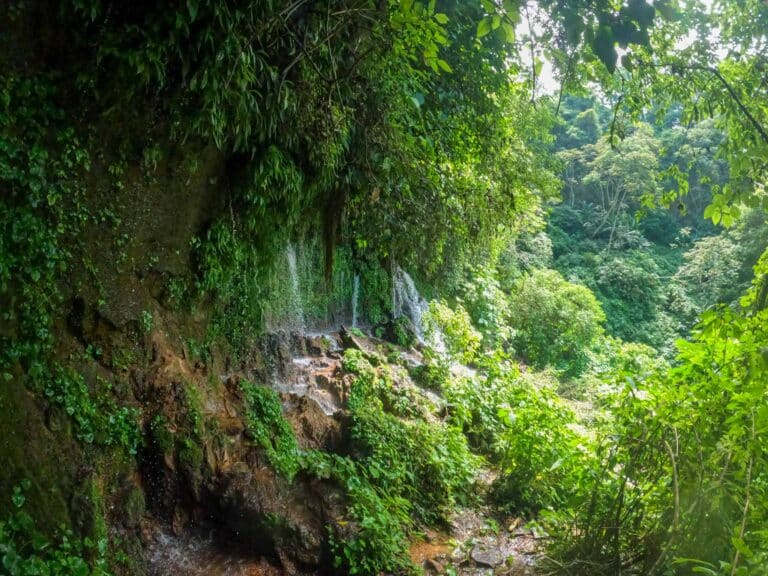
Looking for things to do nearby? Why not discover the Ruta de las Flores?
OTHER AMAZING THINGS TO DO NEAR THE SANTA ANA VOLCANO, EL SALVADOR
#1 EXPLORE THE RUTA DE LAS FLORES
Set amongst hills of coffee plantations, lush green landscapes, and peaceful villages, the Ruta de las Flores is yet another reason to visit El Salvador. This area feels a million miles away from the madness of San Salvador and Santa Ana. There’s tons to do in this area, including hiking, natural hot springs, touring coffee plantations, or taking a cookery class. If you’re an adrenaline junkie, you can also try zip-lining and sky cycling!
Base yourself in one place, or town-hop and stay somewhere different each night. How you explore the route of the flowers is up to you. But one thing’s for sure – you won’t run out of things to do!
#2 VISIT EL IMPOSIBLE NATIONAL PARK
El Imposible National Park is the largest national park in El Salvador. It’s close to both Santa Ana and and Juayúa, and is certainly worth a visit! The national park is home to more than 500 species of plants, over 100 species of mammals and, amazingly, more than 5,000 species of butterflies. And if you’re chasing those cascadas, there’s loads to discover here too!
There are also Mayan ruins here. They’re cool to have a look around, although you might not be too amazed if you’ve seen any of the big three: Guatemala’s Tikal, Honduras’ Copan Ruinas, and Mexico’s Chichen Itza.
#3 DO JUAYUA'S 7 WATERFALLS HIKE
Well, I say ‘hike’. But on this adventure, you won’t just be wandering along a trail to a viewpoint. You’ll be rappelling up, diving underneath, and jumping over a series of waterfalls in the Salvadoran jungle. It’s an amazing experience, and you shouldn’t leave El Salvador without doing it!
#4 RELAX AT LAKE COATEPEQUE
Lake Coatepeque is a stunning crater lake located in western El Salvador, nestled amidst volcanic landscapes. With a surface area of approximately 26 square kilometres, it is one of the largest lakes in the country.
Book into Captain Morgan Hostel for a few nights to relax at one of the coolest hostels around! There are free bikes, tons of watersports, and enough hammocks to go around.
IS THE SANTA ANA VOLCANO HIKE WORTH IT?
Yes! The Santa Ana Volcano hike is so worth it. Santa Ana Volcano is one of the best day hikes in El Salvador (tied for first place with the Seven Waterfalls Hike). As a bonus, you can also say that you’ve climbed the highest peak in El Salvador too!
The Santa Ana Volcano is one of the easiest volcano hikes we did in Central America, and you get to experience the most unique and beautiful crater lake. If you’ve never climbed an active volcano before, this is a great place to start because it’s low-effort and high reward!
It’s also so budget-friendly, especially compared to hiking volcanoes in other countries, such as Costa Rica and Guatemala. These countries cater to larger numbers of tourists, and prices definitely reflect this! Don’t skip the Santa Ana Volcano hike in El Salvador – you’ll regret it!

The colours around the crater are insane!
FAQs
IS SANTA ANA VOLCANO ACTIVE?
Yep! Rhe Santa Ana Volcano is one of the most active volcanoes in El Salvador. If you look down into the crater lake you’ll see it smoking and bubbling away. Don’t worry though, it doesn’t erupt often. The last significant eruption occurred on October 1, 2005, and the one before that was over 100 years ago.
CAN YOU SWIM IN SANTA ANA VOLCANO CRATER?
Erm… no. Although it looks stunning, the pH level of the water is 1, which is about as acidic as you can get. It’s also really hot, and the toxic gases would definitely not be good for you! We definitely wouldn’t recommend it. If you get too close to the edge, the guards will also tell you off!
IS EL SALVADOR SAFE TO VISIT?
Yes. We felt that it was one of the safest and most accommodating places in Central America. The people of El Salvador know the bad reputation their country has, and they want to change that. They are kind, considerate, and genuinely want to help. Since the last few years, El Salvador is just as safe as Nicaragua, and Guatemala, maybe even more so!
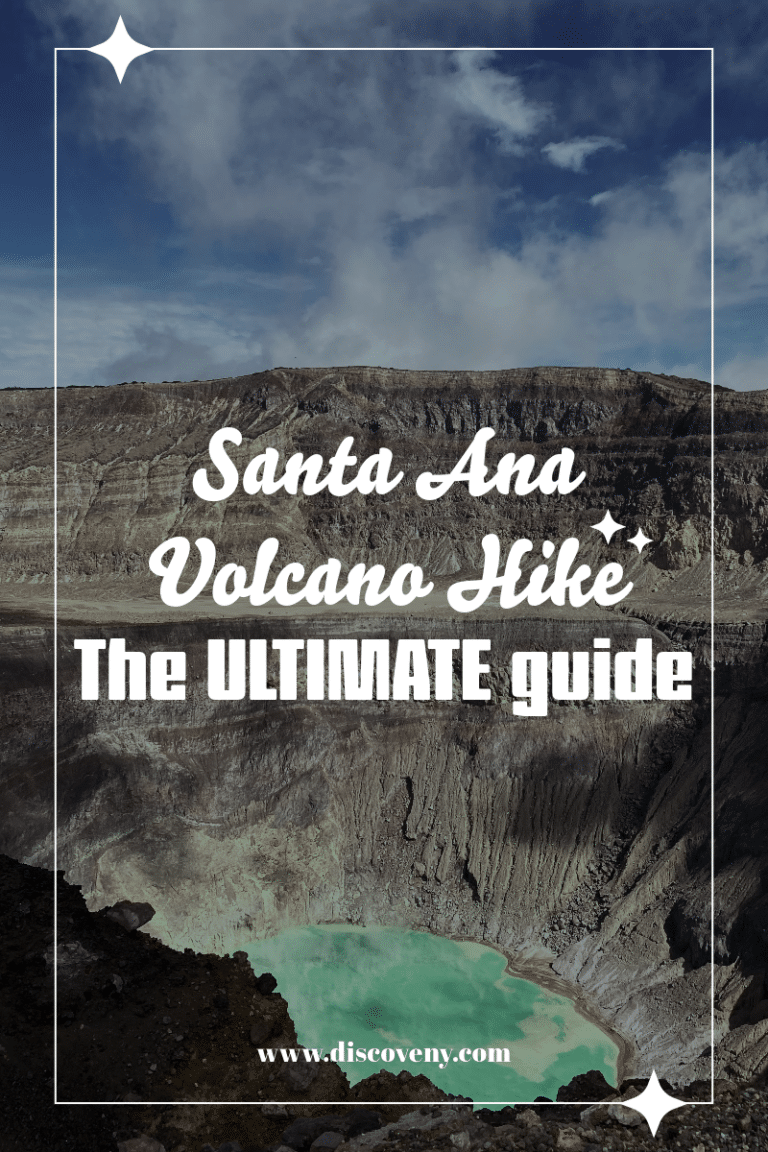
Follow our daily adventures on Facebook and Instagram
Disclaimer: The information and advice provided in this blog are the author’s opinions and based on their personal experiences. All information was accurate at the time of writing. However, things can change quickly, so always double-check current conditions and guidelines before setting out. Remember, your travels and safety are your own responsibility, and this blog can not be held responsible for anything that might happen on your adventures! Always exercise caution and good judgment. Oh, and don’t forget to get travel insurance! Happy travels!
This post may contain affiliate links (yay for transparency!) This means that I will earn a small commission, at no additional cost to you, if you click the link and choose to buy the product. I only link to stuff I have personally bought and found useful and never endorse crap. Your support helps keep the site going, thank you!
Alice
Alice is a UK travel blogger who advocates sustainable travel and being more eco-conscious on a budget. She loves coffee, her houseplants and summiting mountains.
You May Also Like
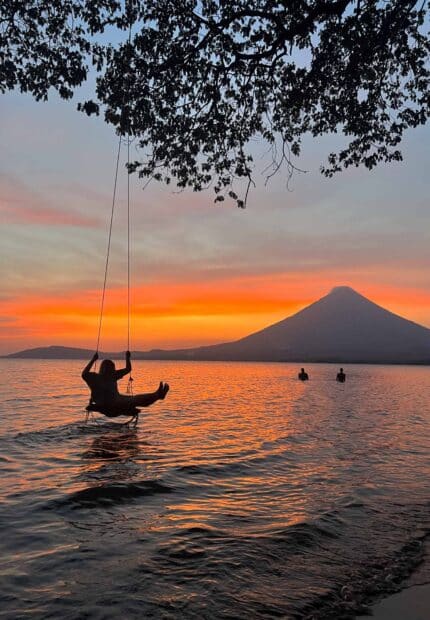
Do I Need to Speak Spanish to Travel in Central America?
April 13, 2024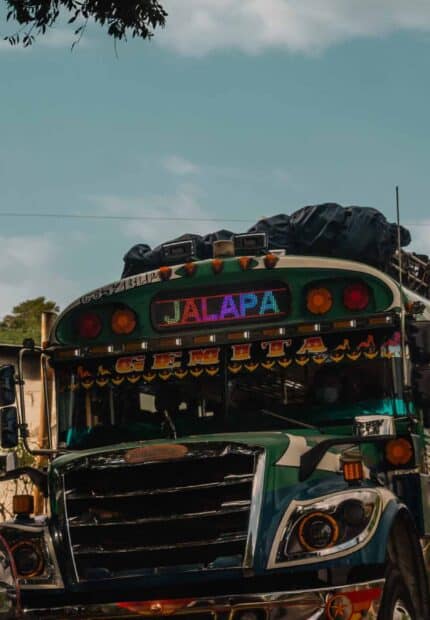
Chicken Buses in Central America: The Ultimate Guide
October 1, 2023